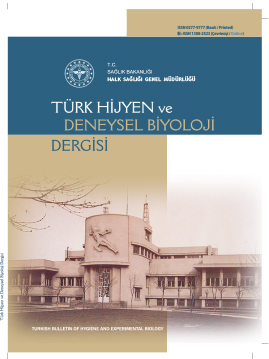
Bu eser Creative Commons Alıntı-GayriTicari-Türetilemez 4.0 Uluslararası Lisansı ile lisanslanmıştır.













Klinik örneklerden izole edilen Acinetobacter baumannii’nin fenotipik ve genotipik özelliklerinin araştırılması
Nezahat KOŞAR1, Djursun KARASARTOVA2, Ayşe Semra GÜRESER3, Ayşegül TAYLAN ÖZKAN41Mikrobiyoloji Laboratuvarı, Erbaa Devlet Hastanesi, Tokat, Türkiye2Hitit Üniversitesi, Tıp Fakültesi, Tıbbi Mikrobiyoloji Anabilim Dalı, Çorum, Türkiye
3Türkiye Sağlık Bilimleri Üniversitesi, Dr. Abdurrahman Yurtaslan Ankara Onkoloji Eğitim ve Araştırma Hastanesi, Tıbbi Mikrobiyoloji Kliniği, Ankara, Türkiye
4Uluslararası Kıbrıs Üniversitesi, Tıp Fakültesi, Lefkoşa, KKTC
GİRİŞ ve AMAÇ: Acinetobacter baumannii dünya çapında yaygın bir nozokomiyal patojendir. Çalışmamızda Çorum Erol Olçok Eğitim ve Araştırma Hastanesine başvuran hastaların klinik örneklerinden izole edilmiş olan A. baumannii izolatlarının antibiyotik direnç oranı, blaOXA ve ISaba1 genleri, metallo-beta-laktamaz üretimi, biyofilm oluşumu ve klonal sınıflandırmasının belirlenmesi amaçlanmıştır. Ayrıca plazmid profilini tanımlamak ve genler, klonlar ve plazmidler arasındaki ilişkiyi analiz etmek de amaçlanmıştır.
YÖNTEM ve GEREÇLER: 2018 ve 2019 yılları arasında izole edilen 98 A. baumannii çalışmaya dahil edilmiştir. Antibiyotik duyarlılık testleri Vitek 2 otomatize sistemi ile belirlenmiştir. Kolistin duyarlılığı için referans yöntem olan sıvı mikrodilüsyon yöntemi kullanılmıştır. Sıvı mikrodilüsyon ile Vitek 2’den elde edilen sonuçlar karşılaştırılmıştır. BlaOXA-23, blaOXA-24/40, blaOXA-51 ve blaOXA-58 genleri multipleks polimeraz zincir reaksiyonu ile tespit edilmiştir. ISAba1/blaOXA-23 ve ISAba1/blaOXA-51 genleri PCR ile saptanmıştır. İzolatların genotipleri ve alt tipleri Repetitive Extragenic Palindromic PCR yöntemi ile belirlenmiştir. Uluslararası klonlar multipleks PCR ile araştırılmıştır. İzolatların plazmid profilleri ise alkali lizis yöntemi ile saptanmıştır. Biyofilm oluşumu ve metallo-beta-laktamaz üretiminin belirlenmesinde ise fenotipik yöntemler kullanılmıştır.
BULGULAR: A. baumannii derin trakeal aspirat örneklerinde (%32), yarada (%21), kanda (%17), balgamda (%15), idrarda (%9), doku biyopsi örneklerinde (%4), plevral sıvıda (%1) ve beyin omurilik sıvısında (%1) saptanmıştır. Yoğun bakım ünitesinden alınan hasta örneklerinde A. baumannii %58 sıklıkta tespit edilmiştir. İzolatların %13’ü test edilen tüm antibiyotiklere duyarlı iken %45’inde yaygın antibiyotik direnci olduğu bulunmuştur. Karbapenem dirençli izolatların %98,8’inde ISAba1/ blaOXA-23, ISAba1/ blaOXA-51, blaOXA-23, blaOXA-51 genleri tespit edilmiştir. BlaOXA-24/40 ve blaOXA-58 genleri saptanmamıştır. Epidemiyolojik sınıflandırmada yedi genotip ve 21 alt tip saptanmıştır. Hastane endemik izolatı olarak Genotip D ve uluslararası klon 2 tanımlanmıştır. İzolatların %73,4’ünün plazmid taşıdığı ve bu plazmidlerin izolatlar arasında farklılık gösterdiği belirlenmiştir. İzolatların %88’inde farklı biyofilm seviyeleri ölçülürken seftazidim, imipenem, meropenem, trimetoprim-sülfametoksazol ve siprofloksasine duyarlı izolatlarda daha güçlü biyofilm oluşumu tespit edilmiştir.
TARTIŞMA ve SONUÇ: A. baumannii izolatlarında blaOXA-23 genotipi karbapenem direnci ile ilişkilidir. Genotip D ve uluslararası klon 2 hastanemizin endemik izolatı olarak tanımlanmış olup izolatların plazmid profilleri, genotipler ve klonalite açısından duyarlı ve dirençli izolatlar arasında benzerlik saptanmamıştır. Seftazidim, imipenem, meropenem, trimetoprim-sülfametoksazol ve siprofloksasine duyarlı izolatlarda daha güçlü biyofilm oluşumu tespit edilmiştir ve biyofilm oluşumu ile antibiyotik direnci arasındaki ilişki konusunda daha geniş kapsamlı çalışmaların yapılmasına ihtiyaç olduğu kanaatine varılmıştır.
Investigation of phenotypic and genotypic characteristics of Acinetobacter baumannii isolated from clinical samples
Nezahat KOŞAR1, Djursun KARASARTOVA2, Ayşe Semra GÜRESER3, Ayşegül TAYLAN ÖZKAN41Microbiology Laboratory, Erbaa State Hospital, Tokat, Türkiye2Department Of Medical Microbiology, Faculty Of Medicine, Hitit University, Çorum, Türkiye
3Clinic Of Medical Microbiology, University Of Health Sciences Turkey, Dr. Abdurrahman Yurtaslan Ankara Oncology Training And Research Hospital, Ankara, Türkiye
4Faculty Of Medicine, International Cyprus University, Nicosia, North Cyprus
INTRODUCTION: Acinetobacter baumannii strains are common nosocomial pathogens worldwide. Our study aimed to determine the antibiotic resistance rate, blaOXA and ISAba1 genes, metallo-beta-lactamases production, biofilm formation, and clonal classification of A. baumannii isolated from clinical samples in Çorum Erol Olçok Training and Research Hospital, Türkiye. It was also aimed to describe the plasmid profile and analyze the association between genes, clones, and plasmids.
METHODS: Ninety-eight A. baumannii isolated between 2018 and 2019 were included in the study. Antibiotic susceptibility tests were determined with Vitek 2. The reference broth microdilution method was used to assess colistin susceptibility. These results were compared with those obtained from the Vitek 2. A multiplex polymerase chain reaction detected blaOXA-23, blaOXA-24/40, blaOXA-51, and blaOXA-58 genes. The ISAba1/ blaOXA-23 and ISAba1/ blaOXA-51 genes were analyzed separately via PCR. Genotypes and subtypes of the isolates were determined with the Repetitive Extragenic Palindromic PCR method. International clones were investigated by multiplex PCR. The plasmid profiles of the isolates were analyzed using alkaline lysis. Phenotypic methods were preferred for determining biofilm formation and metallo-beta-lactamase production.
RESULTS: A. baumannii was identified in deep tracheal aspirate samples (32%), wounds (21%), blood (17%), sputum (15%), urine (9%), tissue biopsy samples (4%), pleural fluid (1%), and cerebrospinal fluid (1%). A. baumannii was detected in patient samples from the intensive care unit at a frequency of 58%. Of these isolates, 13% were susceptible to all antibiotics tested, while 45% were found to be extensively drug resistant. The ISAba1/blaOXA-23, ISab1/blaOXA-51, blaOXA-23, and blaOXA-51 genes were found in 98.8% of the carbapenem-resistant isolates. BlaOXA-24/40 and blaOXA-58 genes were not detected. The epidemiological distribution of the isolates revealed seven genotypes and 21 subtypes. Genotype D was found, and international clone 2 was classified in the hospital epidemic isolates. It was shown that 73.4% of isolates carried plasmids, which were not identical among isolates. Different biofilm levels were measured in 88% of the isolates. However, more vigorous biofilm formation was detected in isolates sensitive to ceftazidime, imipenem, meropenem, trimethoprim-sulfamethoxazole, and ciprofloxacin.
DISCUSSION AND CONCLUSION: The blaOXA-23 genotype was associated with carbapenem resistance in A. baumannii isolates. Genotype D and international clone 2 were defined as endemic isolates in our hospital, and no similarity was found between susceptible and resistant isolates in terms of plasmid profiles, genotypes, and clonality. Stronger biofilm formation was detected in isolates susceptible to ceftazidime, imipenem, meropenem, trimethoprim-sulfamethoxazole, and ciprofloxacin, and more comprehensive studies are needed on the relationship between biofilm formation and antibiotic resistance.
Makale Dili: İngilizce
(130 kere indirildi)


